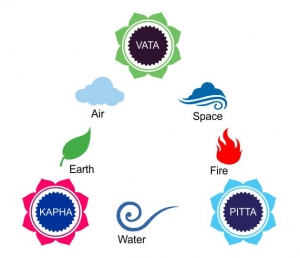Ayurveda is a wholistic system of medicine from India that uses a constitutional model. Its aim is to provide guidance regarding food and lifestyle so that healthy people can stay healthy and folks with health challenges can improve their health.
There are several aspects to Ayurveda that are quite unique:
- Its recommendations will often be different for each person regarding which foods and which lifestyle they should follow in order to be completely healthy. This is due to it’s use of a constitutional model.
- Everything in Ayurveda is validated by observation, inquiry, direct examination and knowledge derived from the ancient texts.
- It understands that there are energetic forces that influence nature and human beings. These forces are called the Tridoshas.
- Because Ayurveda sees a strong connection between the mind and the body, a huge amount of information is available regarding this relationship.
Origin
Ayurveda is an intricate system of healing that originated in India thousands of years ago. We can find historical evidence of Ayurveda in the ancient books of wisdom known as the Vedas. In the Rig Veda, over 60 preparatison were mentioned that could be used to assist an individual in overcoming various ailments. The Rig Veda was written over 6,000 years ago, but really Ayurveda has been around even longer than that. What we see is that A yurveda is more than just a medical system. It is a Science of Life. We are all part and parcel of nature. Just as the animals and plants live in harmony with nature and utilize the Laws of Nature to create health and balance within their beings, we, too, adhere to these very same principles. Therefore, it is fair to say that Ayurveda is a system that helps maintain health in a person by using the inherent principles of nature to bring the individual back i nto equilibrium with their true self. In essence Ayurveda has been in existence since the beginning of time because we have always been governed by nature’s laws.
Meaning
Ayurveda is made up of two Sanskrit words: Ayu which means life and Veda which means the knowledge of. To know about life is Ayurveda. However, to fully comprehend the vast s cope of Ayurveda let us first define “Ayu” or life. According to the ancient Ayurvedic scholar Charaka, “ayu” is comprised of four essential parts. The combination of mind, body, senses and the soul.
Mind, Body, and Senses
We tend to identify most with our physical bodies; yet, in actuality, there is more to us then what meets the eye. We can see that underlying our physical structure is the mind, which not only controls our thought processes but helps assist us in carrying out day-to-day activities such as respiration, circulation, digestion and elimination. The mind and the body work in conjunction with one another to regulate our physiology. In order for the mind to act appropriately to assist the physical body, we must use our senses as information gatherers. We can think of the mind as a computer and the senses as the data which gets entered into the computer. Smell and taste are two important senses th at aid in the digestive process. When the mind registers that a particular food is entering the gastrointestinal tract, it directs the body to act accordingly by releasing various digestive enzymes. However, if we overindulge the taste buds with too much of a certain taste, such as sweet, we may find that the ability of the mind to perceive the sweet taste is impaired; and thereby the body becomes challenged in its ability to process sweet foods. Maintaining the clarity of our senses is an essential part in allowing the mind and body to integrate their functions and help in keeping us healthy and happy individuals.
SOUL
Ayurveda also sees that before we exist in physical form with the help of the mind and senses that we exist in a more subtle form known as the soul. The ancient seers of India believed tha t we were comprised of a certain energetic essence that precluded the inhabitance of our physical entity. In fact, they hypothesized that we may indeed occupy many physical bodies throughout the course of time but that our underlying self or soul remains unchanged. What we see to help illustrate this concept is what transpires at the time of death. When the individual nears the time to leave the physical body, many of his/her desires will cease to be present. As the soul no longer identifies with the bod y, the desire to eat food or indulge in a particular activity that used to be a great source of satisfaction for that person drops by the wayside. In fact, many individuals have been documented to experience the sensation of being “out of their bodies.”
These are just a few examples of how we are made up of these four components that we call life.
Principles
Now that we have a better understanding of what comprises life, let’s look at some of the principles of Ayurveda and how they might affect us.

In Ayurveda we view a person as a unique individual made up of five primary elements. The elements are ether (space), air, fire, water, and earth. Just as in nature, we too have these five elements in us. When any of these elements are present in the environment, they will in turn have an influence on us. The foods we eat and the weather are just two examples of the presence of these elements. While we are a composite of these five primary elements, certain elements are seen to have an ability to combine to create various physiological functions. Ether and air combine to form what is known in Ayurveda as the Vata dosha. Vata governs the principle of movement and therefore can be seen as the force which directs nerve impulses, circulation, respiration, and elimination. Fire and water are the elements that combine to form the Pitta dosha. The Pitta dosha is the process of transformation or metabolism. The transformation of foods into nutrients that our bodies can assimilate is an example of a pitta function. Pitta is also responsible for metabolism in the organ and tissue systems as well as cellular metabolism. Finally, it is predominantly the water and earth elements which combine to form the Kapha dosha. Kapha is what is responsible for growth, adding structure unit by unit. Another function of the Kapha dosha is to offer protection. Cerebral-spinal fluid protects the brain and spinal column and is a type of Kapha found in the body. Also, the mucousal lining of the stomach is another example of the Kapha dosha protecting the tissues. We are all made up of unique proportions of Vata, Pitta and Ka pha. These ratios of the doshas vary in each individual; and because of this, Ayurveda sees each person as a special mixture that accounts for our diversity.
Ayurveda gives us a model to look at each individual as a unique makeup of the three doshas and to thereby design treatment protocols that specifically address a persons health challenges. When any of the doshas ( Vata, Pitta or Kapha ) become accumulated, Ayurveda will suggest specific lifestyle and nutritional guidelines to assist the individual in reducing the dosha that has become excessive. We may also suggest certain herbal supplements to hasten the healing process. If toxins in the body are abundant, then a cleansing process known as Pancha Karma is recommended to eliminate these unwanted toxins.
Conclusion
This understanding that we are all unique individuals enables Ayurveda to address not only specific health concerns but also offers explanation as to why one person responds differently than another. We hope that you will continue to explore Ayurveda to enhance your health and to gain further insights into this miracle we call life.

